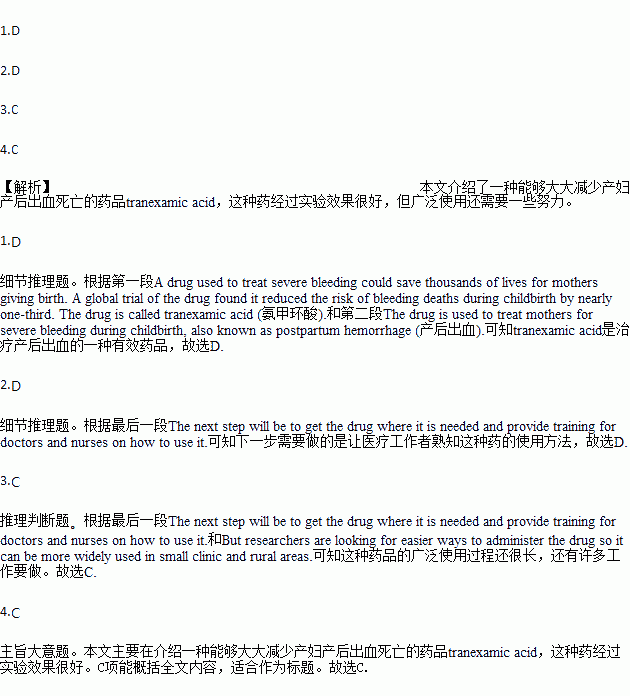题目内容
A drug used to treat severe bleeding could save thousands of lives for mothers giving birth. A global trial of the drug found it reduced the risk of bleeding deaths during childbirth by nearly one-third. The study involved 20,000 women in 21 countries, mainly in Africa and Asia. The trial was carried out by London's School of Hygiene and Tropical Medicine. The drug is called d tranexamic acid (氨甲环酸). It is low-cost and researchers said it does not cause serious side effects for mothers or babies.
The drug is used to treat mothers for severe bleeding during childbirth, also known as postpartum hemorrhage (产后出血).It is the leading cause of mother’s death worldwide, according to the World Health Organization.
Haleema Shakur is the project director of the trial. She says despite medical advances in many countries, severe bleeding after childbirth remains a big problem in some parts of the world. “It's one of the biggest killers of mothers. In Africa and Asia. about 10 percent of women will end up with severe bleeding. " The drug works by stopping blood clots(血凝块) from breaking down after a mother gives birth. The treatment can prevent the need for doctors to perform surgery to find the source of bleeding.
Shakur said the best results were reported when the drug was given to women as soon as possible after childbirth, “The earlier you give it- so within the first three hours of giving birth—the better the effect is. ”
The next step will be to get the drug where it is needed provide training for doctors and nurses on how to use it. During the trial, women were given the drug in a hospital. But researchers are looking for easier ways to administer the drug so it can be more widely used in small clinics and rural areas.
1.Tranexamic acid is a drug that .
A. should be used for every mother
B. helps mothers before giving birth
C. ensures most new-born babies’ health
D. can help mothers giving birth stop bleeding
2.What is the reachers’next plan?
A. To know how much the drug is.
B. To get permission to use the drug.
C. To let more people know the drug.
D. To make medical staff know how to use the drug.
3.What can we learn from the text?
A. The more mothers use the drug, the better its effect is.
B. African and Asian countries made great progress in medicine.
C. There is a long way to go before the drug can be used more widely.
D. Postpartum hemorrhage is the leading cause of women’s death.
4.What may be the best title for the text?
A. Care for the Health of Mothers
B. How Can We Use Tranexamic Acid Well?
C. Childbirth Drug Greatly Reduces Bleeding Deaths
D. What's the Biggest Killer of Mothers?
啊
Central Park Outside among the trees, watch the wildlife—both the human and animal varieties. Call(212) 360-3465 or (212) 360-2726 for daily events and tours. Central Park stretches from 59th to 110th Sts., and from 5th Ave. to Central Park West. | |
Empire State Building This is among the most striking buildings in the city, the nation, even the world. The observation deck (瞭望台) on the 86th floor is open to the general public, offering a wonderful view of the city. On the second floor you'll find the New York Skyride, a simulate helicopter ride over Manhattan. 5th Ave. at 34th St., Midtown: (212) 736-3100 | |
Intrepid Sea-Air-Space Museum Five blocks west of Time Square, this museum has hundreds of air, deep-sea and space exhibits. Walk the flight deck of the 900-foot-long aircraft carrier Intrepid, see dozens of old and modern aircraft and ride the Intrepid Navy Flight Simulator. Pier 86, W. 46th St. and 12th Ave.: (212)245-0072 | |
Madison Square Garden If it's big, it probably happens at the Garden. Check out sporting events, concerts and much more. Tours are available. 7th Ave., btwn. 31st and 33rd Sts., Midtown: (212)465-6741 |
1.The New York Skyride is for .
A. sightseeing B. flight training
C. model plane sports D. city transportation
2.If a visitor is interested in music, he will probably go to .
A. Central Park B. Empire State Building
C. Intrepid Sea-Air-Space museum D. Madison Square Garden
3.What is the purpose of these texts?
A. To provide information of living in New York.
B. To provide directions of city traffic in New York.
C. To give visitors a guide to New York.
D. To give a brief introduction to the history of New York.

